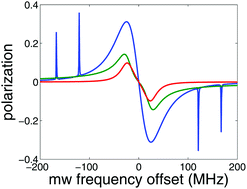Dynamic nuclear polarisation by thermal mixing: quantum theory and macroscopic simulations
Abstract
A theory of dynamic nuclear polarisation (DNP) by thermal mixing is suggested based on purely quantum considerations. A minimal 6-level microscopic model is developed to test the theory and link it to the well-known thermodynamic model. Optimal conditions for the nuclear polarization enhancement and effects of inhomogeneous broadening of the electron resonance are discussed. Macroscopic simulations of nuclear polarization spectra displaying good agreement with experiments, involving BDPA and trityl free radicals, are presented.


 Please wait while we load your content...
Please wait while we load your content...